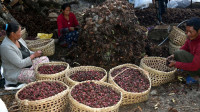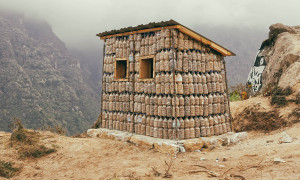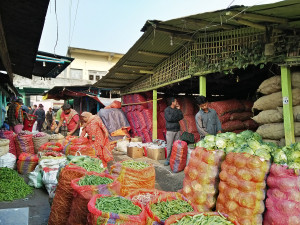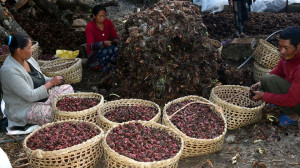Money
Nepal’s 81.8 percent export boom driven by re-exports. Farm goods lag
Exports of domestic production-based items like large cardamom, herbs, ginger, essential oils, lentils, jewellery, vegetables, fruits, spices, and coffee slump.
Krishana Prasain
Nepal’s total exports surged by 81.8 percent in the last fiscal year, reaching Rs277 billion. This growth was primarily driven by re-exports of edible oils—soyabean, sunflower, and palm oil—which Nepal does not produce domestically. Edible oil exports alone jumped more than 15 fold to Rs121.53 billion, accounting for 43.86 percent of total exports.
In contrast, exports of domestic products—particularly those produced by Nepali farmers and manufacturers—increased by just 6.62 percent. This highlights how trading businesses continue to leverage zero-tariff privileges granted to least-developed countries like Nepal.
Exports of high-value products listed under the Nepal Trade Integration Strategy (NTIS) 2023 reached Rs98.87 billion, making up 35.68 percent of total exports. However, implementation of NTIS activities lagged, as the government failed to allocate a budget in the last fiscal year.
“The Industry Ministry has received Rs31.1 million to implement NTIS in the current fiscal year,” said an official at the Ministry of Industry, Commerce and Supplies. “Budget allocation will begin in mid-August, and we’ve asked implementing bodies to submit proposals.”
Officials believe there is strong export potential for NTIS-listed goods, but low investment and funding shortfalls are hindering growth. The government introduced a revised NTIS in July 2023, replacing the 2016 version, in an attempt to boost exports and support Nepal’s graduation from the LDC category by 2026.
Despite these policy ambitions, data reveal sluggish or negative growth in several key product categories. Shipments of iron and steel, readymade garments, large cardamom, medicinal herbs, ginger, essential oils, lentils, jewellery, vegetables, fruits, spices, coffee, Himalayan spring water, and honey all declined in the last fiscal year.
Iron and steel—Nepal’s top export commodities—dropped by 6.01 percent to Rs16.35 billion, contributing 5.9 percent to total exports. Industry insiders say the sector has recently suffered a significant blow. For the past two months, exports of steel utensils to India have halted after the southern neighbour began requiring quality certification for raw materials used in such products.
Previously, India’s Bureau of Indian Standards (BIS) mandated certification only for finished goods, a policy aimed at curbing Chinese imports. But two months ago, the rule was extended to raw materials, severely impacting manufacturers in Nepal, particularly those in the Bhairahawa-based Special Economic Zone (SEZ).
The policy shift builds on a 2020 directive from the Indian government instructing the BIS to enforce global quality standards on imported goods. This directive is widely viewed as an attempt to limit Chinese imports through neighbouring countries.
Readymade garment exports fell 2.39 percent to Rs8.75 billion, with 15.88 million pieces exported, accounting for 3.2 percent of total exports.
Large cardamom exports declined by 3.24 percent to Rs7.68 billion, with 4,301 tonnes shipped. Medicinal herb exports dropped 9.3 percent to Rs2.04 billion, while ginger plummeted by 50.38 percent to Rs583.61 million.
Exports of essential or fragrance oils decreased 9.73 percent to Rs572.79 million. Lentil shipments fell 36.43 percent to Rs361.38 million, with 2,517 tonnes exported. Gold jewellery exports slid 17.79 percent to Rs47.87 million.
Vegetable exports dropped 18.2 percent to Rs165.25 million, with 10,024 tonnes shipped. Fruit exports declined by 47.61 percent to Rs9.96 million, with 312 tonnes exported. Spices fell by 20.14 percent to Rs440.62 million, with 4,481 tonnes—including pepper, cinnamon, and turmeric—shipped.
Coffee exports dropped 23.37 percent to Rs114.37 million, with 63 tonnes exported. Himalayan spring water shipments fell 46.02 percent to Rs4.65 million, totalling 53,344 litres. Honey exports stood at Rs57.45 million, with 8 tonnes shipped.
Amid this overall decline, a few sectors posted gains.
Yarn exports rose 19.85 percent to Rs14.39 billion, contributing 5.2 percent of total exports. Carpet exports grew by 3.9 percent to Rs10.77 billion, with 472,023 square meters exported.
Jute and jute product exports increased by 16.81 percent to Rs8.22 billion. Woollen felt product exports climbed 7.16 percent to Rs5.14 billion.
Tea exports jumped 26.64 percent to Rs4.59 billion, with 15,598 tonnes shipped. According to the Nepal Tea Association, rising production and an increase in average value by 5 to 7 percent helped boost revenue. Crush, tear, curl (CTC) tea was exported at Indian Rs125–150 per kilogram, while orthodox tea fetched around Rs800 per kilogram.
Dog chew exports saw the sharpest growth, rising 41.76 percent to Rs4.51 billion. Nepal exported 2,610 tonnes of dog chews. However, industry players warn that rising milk prices could threaten competitiveness, as cheaper products from other countries flood the market.
Pashmina exports rose by 6.62 percent to Rs3.22 billion. Fabric exports increased 22.26 percent to Rs3.08 billion. Cement exports grew 12.61 percent to Rs2.21 billion.
Rosin and resin acid exports climbed 39.23 percent to Rs2.05 billion. Footwear exports surged 54.20 percent to Rs2.04 billion, while handmade paper shipments rose 19.76 percent to Rs1.22 billion. Silver jewellery exports also increased by 6.98 percent to Rs178.71 million.




 10.12°C Kathmandu
10.12°C Kathmandu













%20(1).jpg&w=300&height=200)
